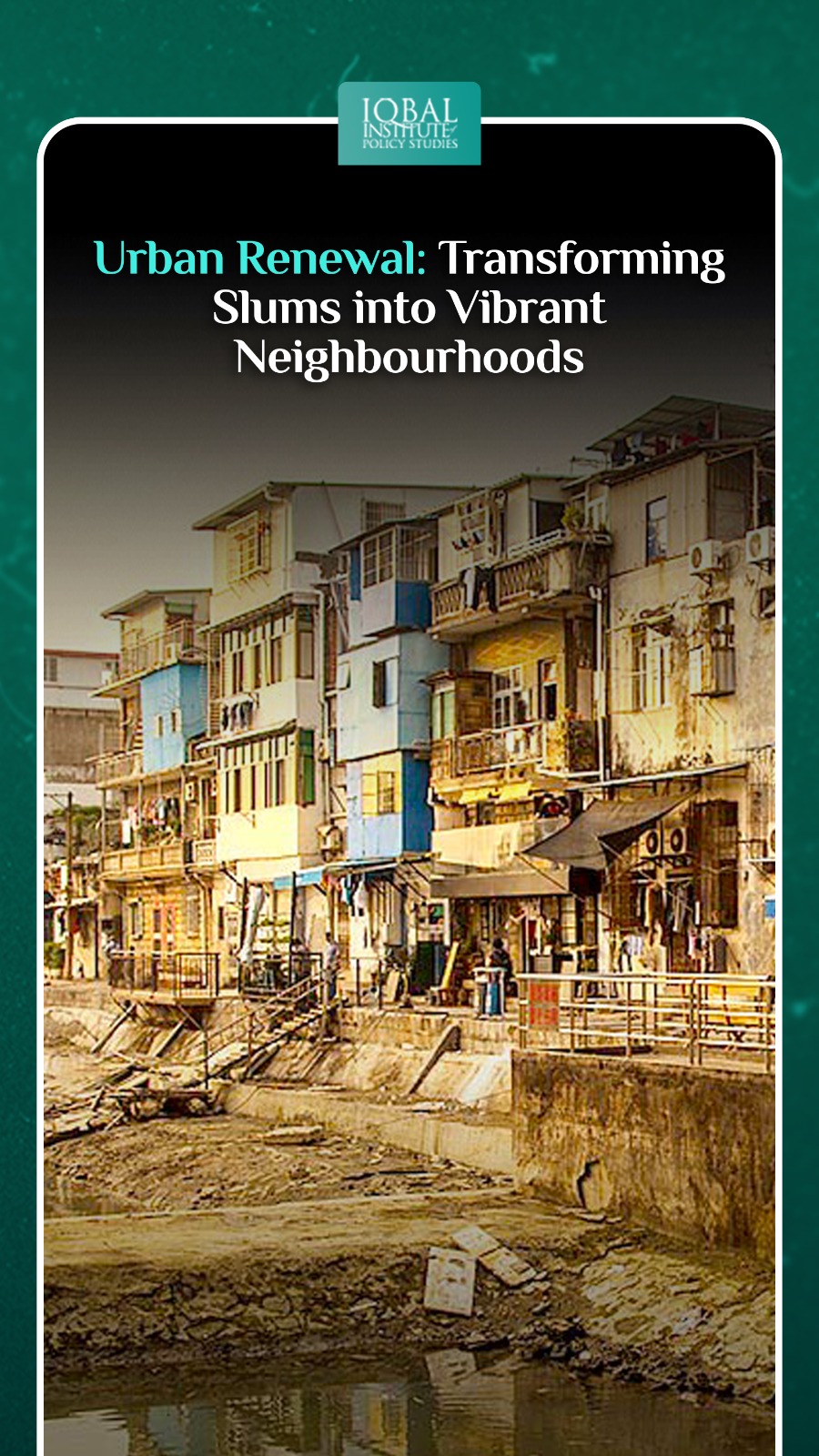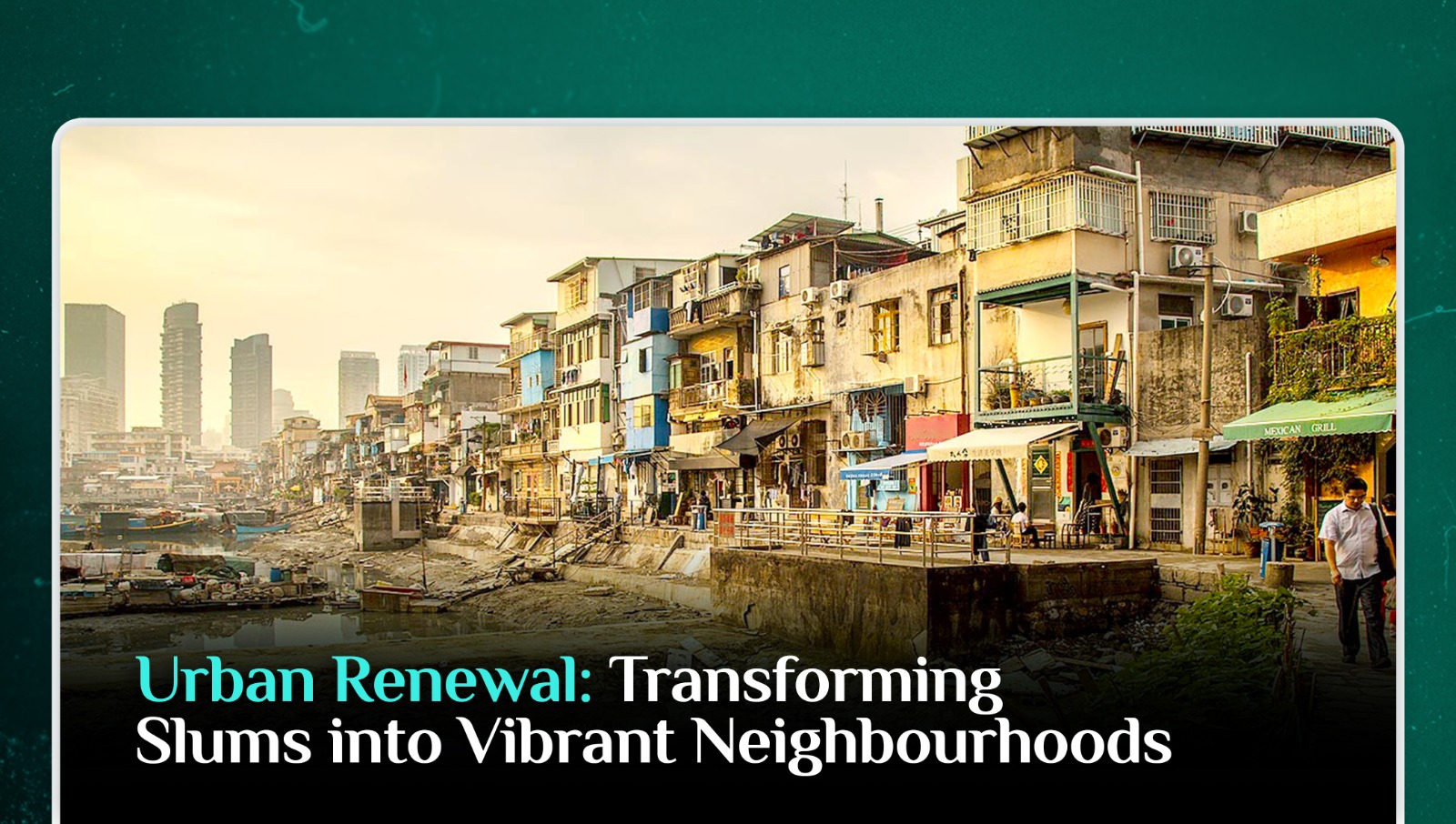Many developing countries are struggling with the slum issue as the globe becomes an urbanised colony, which has a negative impact on housing conditions, air pollution, and the availability of essential urban services and infrastructure. The issue of slums and informal settlements is worsening every day in Pakistan. Various slum improvement ideas and methods have been suggested to combat urban poverty. The measures that can assist turn slums into thriving neighbourhoods will be briefly discussed in this blog.
Introduction
Slums have a great deal of potential to be transformed into thriving neighbourhoods through the process of urban regeneration, which is used to revitalise damaged urban areas. It entails a variety of initiatives geared towards enhancing the built environment, societal circumstances, and economic prospects. Slums are transformed in a substantial and complex way by urban regeneration. Slums, which are marked by subpar housing, few services, and subpar living circumstances, are widespread around the world, including Pakistan. Strategic urban redevelopment efforts may revitalise these neglected communities, promoting sustainable development, social harmony, and an improvement in the standard of living for the locals.
Understanding Slums and Their Challenges
Slums, often referred to as informal settlements, are a result of rapid urbanisation, migration from rural to urban areas, and social inequality. Immigrant, low-income, and disadvantaged households build slums, which present problems such as overpopulation, bad infrastructure, poverty, a lack of basic commodities, and inadequate medical and educational services.
Moreover, some of the major issues are listed below:
Housing
Homes in slums are frequently improvised, packed tenements, or shanties fashioned of inferior materials. They are vulnerable to risks like fire and floods because they lack adequate ventilation and sanitary amenities.
Essential infrastructure and services
Slums have been noted to lack vital infrastructure and services such as clean water, sanitation, power, and waste management. Slums are notorious for missing necessary infrastructure and services including power, drinking water, sanitation, and waste management. Slum residents struggle, and their lack of access to transportation, healthcare, and education only makes things worse
Poverty and inequality
Low-income individuals and families, who make up the bulk of the population in these areas, face extreme poverty and inequality. Lack of career opportunities, low salary, and social aid exacerbate their financial problems.
Health and Sanitation
Poor sanitation practises are usually seen in slums, which results in unclean living conditions and an increased risk of waterborne infections.
Crime Situation
Slums are typically connected with greater rates of crime and insecurity due to issues such as unemployment, poverty, ineffective law enforcement, and restricted access to justice. Slum communities now have a much harder time thriving and expanding.
The Potential of Urban Renewal
Urban renewal offers a promising approach to addressing the challenges faced by slums and creating vibrant neighbourhoods. By focusing on physical, social, and economic transformations, urban renewal initiatives can bring about positive changes, enhancing the living conditions and opportunities for slum residents.
Physical Redevelopment
Rebuilding the slums’ physical infrastructure is essential for raising living conditions. A better-designed built environment is healthier and more sustainable when housing facilities are upgraded, access to clean water and sanitation is made available, road networks are well-planned, and green areas are implemented.
Social Integration
Urban revitalization initiatives should emphasise social integration to promote a sense of community and belonging. This may be accomplished through fostering social cohesiveness among various demographics and encouraging individuals to actively participate in decision-making processes through community engagement programmes.
Economic Empowerment
The key to ending the cycle of poverty in slums is to provide sustainable economic possibilities. Initiatives for urban redevelopment may emphasise the provision of jobs, assistance for small businesses, and programmes for vocational training, giving slum inhabitants more economic security and higher standards of living.
Access to Basic Services
Ensuring that residents have access to basic services is critical for converting slums into thriving areas. To lessen inequities and improve the quality of life for people, efforts should be made to offer dependable energy, healthcare facilities, education centres, and other critical services nearby the slum settlements.
Success Stories and Best Practices
Several international success stories highlight the slums’ ability to transform through urban regeneration.
Kenya
For instance, the Kibera Public Space Project, which focused on developing public spaces, renovating housing, and encouraging community interaction, has significantly improved the Kibera slum in Nairobi, Kenya.
Brazil
Another motivating example is the Favela-Bairro project in Rio de Janeiro, Brazil, which shows how slums may be successfully incorporated into urban life through infrastructural upgrades, social initiatives, and increased security measures.
India
Moreover, Dharavi, one of Asia’s largest slums located in Mumbai, India, has been the focus of a redevelopment project. The Project has grabbed global attention with an aim to provide improved housing, infrastructure, and economic opportunities while preserving the existing community fabric. Furthermore, it aims to combine social, economic, and environmental elements in order to create a sustainable and inclusive community.
The value of comprehensive methods, community engagement, long-term planning, and collaborations between the public and private sectors may be highlighted by learning from these successful examples. Such examples emphasise the significance of involving slum residents in the planning and implementation processes, fostering social cohesion, and promoting sustainable development. While each country’s context may vary, these best practices provide valuable insights and lessons for other nations seeking to transform slums and uplift the lives of their residents.
The Way Forward: Collaborative Efforts and Policy Support
The successful transformation of slums and sustainable urban renewal requires collaborative efforts and strong policy support from various stakeholders. Collaboration is necessary to successfully turn slums into lively neighbourhoods. To create comprehensive urban regeneration programmes, acquire funds, and guarantee sustainable execution, governments, local authorities, community organisations, and international players must collaborate. A favourable atmosphere for urban regeneration programmes may also be created through laws that place a priority on social welfare, affordable housing, and inclusive urban development. Governments should create enabling environments through comprehensive slum upgrading policies, land regularisation measures, and tenure security provisions. Additionally, policies should promote affordable housing, access to basic services, and inclusive economic opportunities. Coherent regulations can incentivise public-private partnerships and attract investment for sustainable urban renewal projects.
Conclusion
Slums may be transformed into thriving, inclusive, and sustainable neighbourhoods via urban regeneration. Urban redevelopment programmes can end the cycle of poverty, improve living circumstances, and provide slum inhabitants with equitable opportunities by addressing the physical, social, and economic aspects of slum communities. We can build cities that are marked by social fairness, resilience, and thriving communities where each person has the opportunity to succeed and contribute to urban prosperity via cooperative efforts and policy support.
This article is written by Radma Nouman. Radma is a Research Analyst at the Iqbal Institute of Policy Studies (IIPS).



Leave a Reply